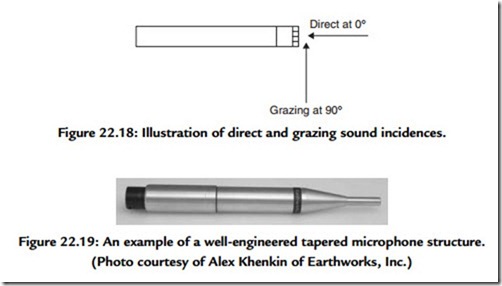Measurement Microphones
A collection of measurement microphones, whether residing in sound level meters or stand-alone devices, is an absolute necessity for sound system installers as well as acoustical consultants. Such a collection must also be supported by an appropriate microphone calibrator system that consists of both the calibrator itself and a set of adapters to accommodate the various individual sizes of the microphones in the collection.
For many years there were only two suppliers of quality measurement microphones: Brüel and Kjaer, a Danish firm, and GenRad, a domestic firm. Brüel and Kjaer still exists, although not under the original ownership, while GenRad no longer exists. Fortunately, there are now several new domestic suppliers of quality measurement microphones.
Measurement microphones are dominantly air capacitor or electret capacitor microphones while ceramic piezoelectric units may still be encountered. The standard sizes in terms of capsule diameter are 1 inch, ½ inch, ¼ inch, and 1⁄8 inch. The larger units have higher sensitivity and lower noise floors. The 1-inch unit is favored for making measurements in quiet environments at frequencies below about 8 kHz. The ½-inch unit is a general purpose one but has high frequency limitations.
Broad frequency band measurements usually require the ¼- or 1⁄8 -inch variety, particularly if high sound levels are to be encountered. All sizes can have low-frequency responses that extend almost to 0 Hz, with 3 to 5 Hz being typical with even lower values being possible. A slow leak for allowing the capsule’s rear chamber pressure to follow weather-induced atmospheric pressure variations determines the low-frequency limit.
The geometry of a measurement microphone’s physical structure is that of a cylinder with the central axis of the cylinder being perpendicular to the plane that contains the microphone capsule’s circular diaphragm. This central axis serves as a reference direction for sound incident on the microphone. Direct sound arrives at 0° relative to this axis while grazing incidence occurs at 90°, as illustrated in Figure 22.18.
Any measurement microphone should be encased in such a fashion that the microphone’s physical structure disturbs the sound field in which it is immersed to a minimum degree. When the microphone capsules are smaller than ½ inch in diameter it is impossible to incorporate the necessary circuitry and connector in a uniform cylinder having a diameter equal to that of the capsule. In such instances it is necessary to enclose the circuitry and connector in a larger cylinder that is joined to the capsule by a smoothly tapered section matching the larger diameter to the smaller diameter. A notable example of this is displayed in Figure 22.19.
(a) Measurement Microphone Types
Despite the smoothness of the microphone enclosure, one cannot escape the fact that at high frequencies the microphone capsule diameter, d, is comparable to the sound
wavelength, λ. When this occurs, the sound field is disturbed by reflection from the capsule’s diaphragm as well as diffraction by the capsule’s protective grid and the microphone housing. The degree of this disturbance depends on the angle of incidence of the sound and is greatest for direct incidence.
The acoustic pressure at the diaphragm for directly incident sound at high frequencies can, in fact, exceed by several decibels that which would have existed in the free field. The free field pressure is that which would have existed if the obstacle

